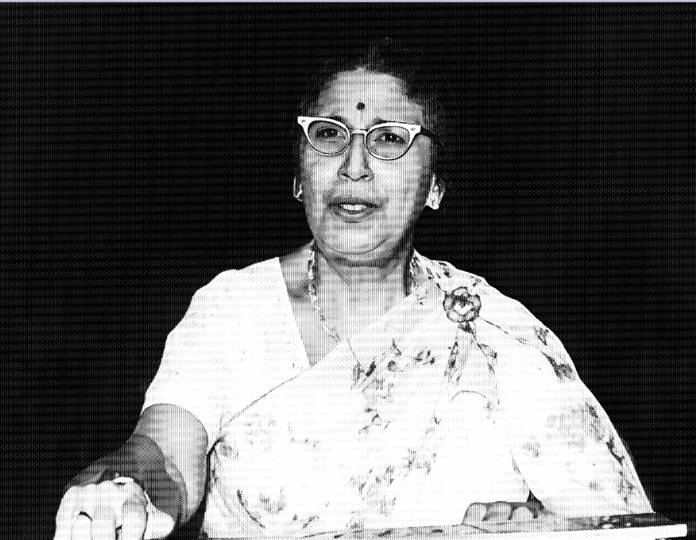Saraswati Devi was one of the pioneering music directors of early Indian music who not only carved a niche for herself in an era dominated by men but dominated the music scene with songs like “Main Ban Ke Chidiya (Achhut Kanya),” “Gaon Ki Maat hamari (“Janmabhoomi),” “Koi hamdam na rahaa koi sahaara na rahaa (Jeevan Naiya),” “Holi aayi re kaanha braj ke basiya (Jeevan Prabhat),” “Ek Chatur Naar Kar Kar Singaar (Jhoola),” and many more.
Early Life
Born as Khurshid Mankesha Minocher-Homji in 1912, in a Parsi family, Saraswati Devi’s journey into the world of music was as melodious as it was groundbreaking. Saraswati Devi’s love for music was evident from a young age. Her father, recognising her talent, ensured she received formal training in Hindustani classical music. She learn under the tutelage of Vishnu Narayan Bhatkhande, a name synonymous with the Dhrupad and Dhamar styles of singing. Her education continued at the Marris College (now Bhatkhande Music Institute) in Lucknow.
Her career took a significant turn when she, along with her sister Manek, performed on All India Radio in Mumbai in the late 1920s. Their program, ‘The Homji Sisters’, became a hit among listeners. This exposure led to an encounter with Himanshu Rai, the founder of Bombay Talkies. Rai was in search of a classical music expert for his films. His offer to head the music department at Bombay Talkies marked the beginning of her illustrious career in films.
Saraswati Devi In Films

Saraswati Devi’s path was not without obstacles. The Parsi community, to which she belonged, was not supportive of women working in cinema. To protect her identity and continue her passion, she adopted the name Saraswati Devi, while her sister became known as Chandraprabha.
Saraswati Devi’s first assignment was the movie “Jawani Ki Hawa” in 1935. The challenge of making actors sing in the absence of playback technology led her to simplify tunes and innovate with the music. Her breakthrough came with the film “Achut Kanya” in 1936, where she composed the memorable score “Mein Ban ki Chiriyra Banke Bun Bun Bolun Re.” The film, starring Ashok Kumar and Devika Rani, established her as a formidable talent in the industry.
She then gave music in films like “Janmabhoomi (1936),” “Jeevan Naiya (1936),” “Mamta (1936),” “Izzat (1937),” “Jeevan Prabhat (1937),” “Prem Kahani (1937),” “Savitri (1937),” “Bhabi (1938),” “Nirmala (1938),” “Vachan (1938),” “Durga (1939),” “Kangan (1939),” “Navjeewan (1939),” “Azad (1940),” “Bandhan (1940),” “Prithvi Vallabh (1940),” “Jhoola (1941),” “Naya Sansar (1941),” “Bhakt Raidas (1943),” “Prarthana (1943),” “Dr. Kumar (1944),” “Parakh (1944),” “Aamrapali (1945),” “Maharani Mrinal Devi (1946),” “Khandani (1947),” “Naqli Heera (1948),” “Usha Haran (1949),” “Kunwara Pati (1950),” “Inaam (1950),” and “Babasa Ri Laadi (1961).”
The Pioneer
Saraswati Devi’s work in the 1930s and 1940s set a precedent for future generations of music directors. Saraswati Devi often used classical bases for her compositions. She famously used Raag Mand for songs in Izzat (1937) and Jeevan Prabhat (1937). She used other raags for her work in Prem Kahani (1937), Savitri (1937), Bhabi (1938), and Nirmala (1938). In Durga (1938), she used Raag Bhairavi to great effect. Sarswati Devi showcased her deep understanding of Indian classical music and its application in cinema.
In 1936, she made ‘Jai Jai Janani Janmabhoomi (Janmabhoomi)’, a song resonated with the spirit of the Indian independence movement. It was one of the first nationalistic songs in Hindi cinema. The chorus of this song was even used by the BBC as a signature tune for its Indian News Service.
Some of her notable songs include “Jai Jai Pyari Janmabhoomi Mata,” “Koi Humdam Na Raha Koi Sahara Na Raha,” “Apne Bhaiya Ko Naach Nachaoongi,” “Chane Jor Garam Babu Main Laya Mazedar,” “Kaise Chhipoge Ab Tum Kaise Chhipoge,” “Manbhavan Manbhavan Lo Sawan Aaya Re,” “Piyu Piyu Bol Piyu Piyu Bol,” “Main Toh Dilli Se Dulhan Laya Re,” “Ek Dhundhla Sa Mohabbat Ka Naksha Hai Baaki,” “Kaahe Neha Lagaye Sajaniya,” and many more.
Sarsawati Devi also sang songs, which include “Kit Gaye Ho Khevanhar Naiya Doobti,” “Hori Aayi Re Kanha Braj Ke Basiya,” “Duniya Kahti Mujhko Paagal,” “Gaon Ki Maati Maat Hamari,” “Hori Aayi Re Kanha Braj Ke Basiya,” “Mero Lalna Jhoole Paalna,” “Ankhiyan Jhapi Mori,” “Barkha Aay Gayi Chalo Chhaani Chhaven,” “Ka Janoo Kaahu Ki Ghaat Sakhi,” “Nadi Kinare Khadi Sochti Kya,” among others.
Legacy of Saraswati Devi
These compositions not only highlight her musical genius but also reflect the cultural and social milieu of the times. Saraswati Devi’s music continues to be celebrated for its innovation, depth, and ability to strike a chord with listeners across generations.
Kishore Kumar used her song “Koi Humdum Na Raha,” originally sung by Ashok Kumar, in his 1961 film “Jhumroo.” R. D. Burman famously used her song “Ek Chatur Naar Kar Ke Shringar (Jhoola) in the film Padosan.
Saraswati Devi’s contribution to Indian cinema is not just a tale of musical excellence but also a story of determination and breaking barriers. On 9 August, 1980, Sarswati Devi passed away in Mumbai.
Saraswati Devi on IMDB